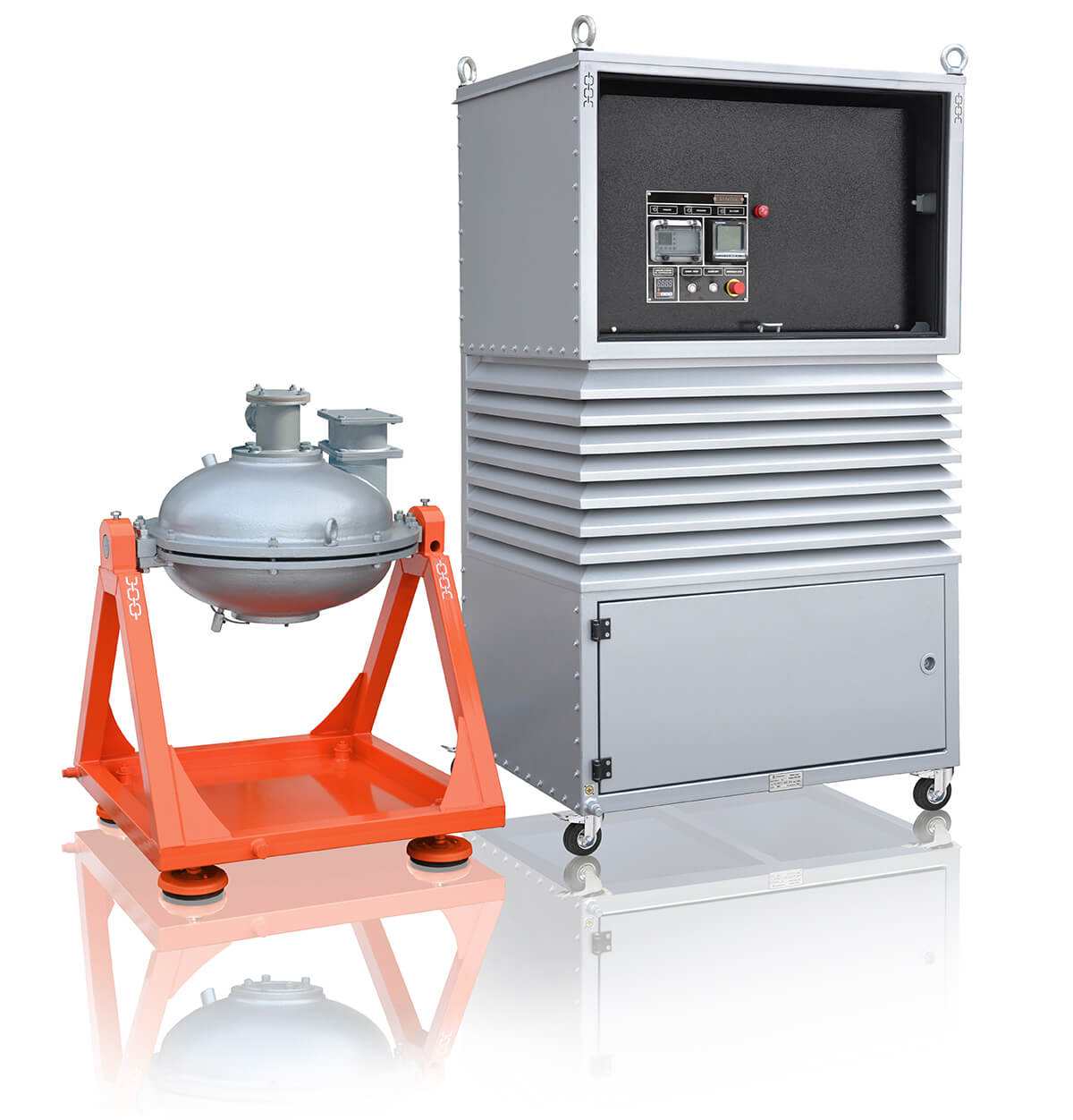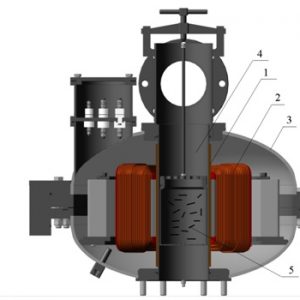Electromagnetic mill AVS-150

AVS mixing and intensifying devices are unique and versatile in their use (a proper list of possible industrial applications will be given below). Besides industrial usage, AVS would also be useful in laboratories for the development of new materials, since it is ideal for mixing processes: frequency and amplitude of resonance are variable in time; resonance intensity is homogeneous throughout the volume of a material to be treated.
The design of the device ensures its reliable and efficient operation. The processes can be performed in cycles or continuously.
The units are airtight and do not have dynamic seals. They consist of an electromagnetic device with a cooling system, working chamber and control panel.
Note: The range of vortex devices includes a few models that differ in capacity and design. Please contact us if you want more information about this unit and its industrial application to your technological processes.
PRINCIPLE OF OPERATION
The operating principle of the AVS device is based on converting energy from the electromagnetic field into other forms of energy. The center of a unit is a chamber (tube) 90-136 mm in diameter, located inside an inductor with the rotating electromagnetic field. Inside of the chamber are cylindrical ferromagnetic elements 0.5 to 5 mm in diameter and 0.5 to 60 mm in length, which react to the surrounding electromagnetic field. Their number can range from several tens to several hundred, depending on the volume of the chamber (fig.4).
Under the effect of the rotating electromagnetic field, the ferromagnetic elements move in the working area and create what is called the “vortex layer”. The vortex layer is a field in which ferromagnetic particles collide millions of times, which in turn allows us to effectively mix and grind everything that is also inside the layer and intensify all of the chemical processes. What would take a usual mill half an hour AVS can grind or mix in one second.

Diagram of the electromagnetic vortex apparatus:
1 – protective sleeve; 2 – inductor of the rotating electromagnetic field; 3 – body of the inductor; 4 – working chamber from non-magnetic material; 5 – ferromagnetic element
The chamber can be designed in several ways depending on the requirements of the processes in the chamber. For liquid phase processes, strainers are installed on the sides of the bush, or at outlet end only. If fibrous materials are processed, labyrinth type strainers are installed. These devices hold the ferromagnetic particles in the work zone.
Consumption of energy in the chamber is defined only by its design, material and the thickness of the walls and does not depend on magnetic field strength. To reduce energy consumption, we manufacture the chamber from a non-magnetic material (stainless steel).
Below are the main industries and processes in which using the Vortex Layer device is the most efficient and cost-effective way to get a qualitatively new product out.
intensification of chemical processes (wastewater and sewage treatment);
rubber manufacturing;
powder metallurgy;
grinding of cellulose;
for the manufacture of metal-polymer composite materials;
foundry;
to form drilling muds;
to produce combustible mixtures for ships;
for the treatment of metal and plastic parts;
cooling of rolling products;
for the regeneration of structured polymers;
for mechanochemical reactions;
synthesis of polymeric products;
activation of solids, etc.
General industries:
Building industry;
Mechanical engineering industry;
Chemical industry;
Agricultural sphere;
Food industry;
Mining industry;
in medicine (pharmacology) and others.
AVS is especially effective for:
formation of suspensions and emulsions with multiple components;
accelerating the processes for forming finely dispersed mixtures, activating dry or dispersed materials in water which improves the physical and chemical properties of the rubber and reduces the vulcanization time;
for the complete purification of industrial wastewater from phenol, formaldehyde, heavy metals, arsenic, cyanides; the acceleration of heat treatment, the formation of protein material from yeast cells;
improvement of the microbiological stability of food products and the activation of yeast in breadmaking;
improving the quality of semi-finished products and finished products made from meat and fish;
intensification of extraction processes, including in the preparation of broths, production of fruit drinks (juices), pectin, etc.
for the production of suspensions and emulsions of high microbiological safety in the food industry without the use of stabilizers, and also to increase the yield of finished products.
AVS-150 Technical characteristics
| Parameter | Type |
| AVS-150 | |
| Max processing rate, m3/hour– water water treatment | 30 |
| – suspension production | 15 |
| Operating pressure, MPa (kg/cm2), max: | 0,25 (2,5) |
| Work zone diameter, mm | 136 |
| Magnetic induction in work zone, Т | 0,15 |
| Electric supply | From AC network |
| Frequency, Hz | 50 |
| Voltage, V | 380 |
| Rotation of magnetic field in work area, RPM | 3 000 |
| Power consumption, kW | 9,5 |
| Dimensions, mm-unit
– control panel |
1300×1100×1 690
1 060×1030×1 900 |
| Weight, kg-unit
– control panel |
500
450 |
- simultaneous pulverization, mixing and activation of processed media;
- super-fine pulverization;
- process intensification. Retention times measured in fractions of a second;
- reduced power consumption;
- raw material economy;
- simple to retrofit into existing processing lines.
